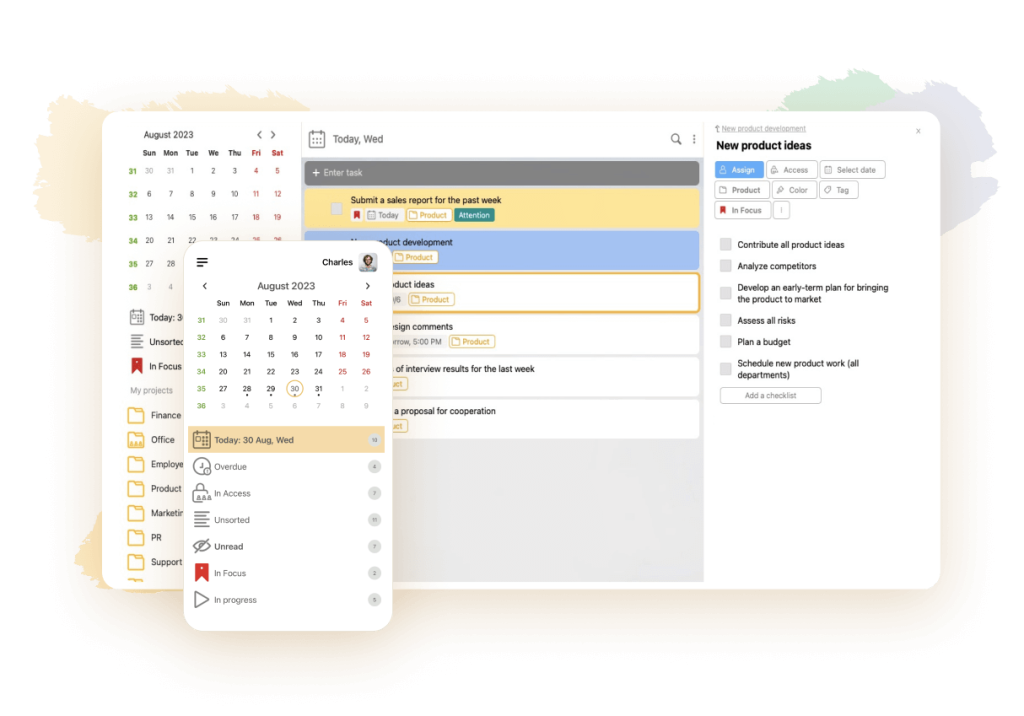Time Management

Chronic lack of time is the scourge of modern man. We work a lot, load our brains, rush all the time and still don’t have time to deal with resource allocation. It’s hard to accept, but this is the reason why we are in a state of constant stress. If you can not deal with a huge number of current problems, it’s time to learn self-organization and competent management of your working and personal time. For this purpose, science has developed a special set of technologies and components that have a common name: time management. We will briefly tell you how to stop procrastinating and deal with the chaos in everyday affairs.
What it is and how it works
Management theory teaches how to allocate time and meet deadlines. This scientific and economic trend has a rich history and includes various techniques, know-how and methods that teach how to allocate tasks and responsibilities in order to always have time for everything. In simple words, this concept means a set of actions or exercises aimed at improving personal and team performance. Time management can be given the following characterization – a composite set of techniques that help not to waste time. Applying even the basics of time management in the professional sphere and personal life, you can master the management of your life processes and learn to always achieve your goals.
The concept of time management encompasses different spheres of activity:
- setting goals, defining mission, strategy;
- time allocation;
- resource management and task delegation;
- prioritization;
- making daily to-do lists;
- time cost estimation analysis;
- improved productivity and personal effectiveness;
- formation of self-discipline and many others.
Modern time management is divided into two main areas:
- personal or individual (used to achieve personal goals);
- corporate or organizational (aims to manage the organization).
Tasks that help to solve
Utilizing this technology in your work or personal life helps you solve many key problems at the same time:
- Accomplish more in less time. Thanks to the ability to plan time, you can take your life “under control”, learn to cope with serious tasks faster to achieve better results.
- Become more successful in all areas. This methodology gives specific recommendations on how to increase productivity, organize work and personal space properly.
- Allocate time for really important things. Due to time deficit, a modern person usually does not have enough time for self-development, favorite hobby or communication with close people. Mastering the skill of time management allows you to effectively deal with “chronophages”. You will be able to get rid of unnecessary cases to do what is really valuable and important. This means that the function of management is mastered and you will be able to live a full, rich and happier life.
- Set realistic goals for yourself and learn how to achieve them. Everyone can dream. Someone imagines himself in the chair of a successful manager, another dreams of a career as an artist, but most desires and aspirations remain unrealized in ordinary life. The ability to plan skillfully transforms abstract dreams into concrete actions. Having clear goals in front of your eyes, it is easier and faster to approach them.
- Managing your life. Most people are dissatisfied with their way of life, but never make an attempt to change anything. As a result, life becomes a “slow drift downstream” that turns into a dreary quagmire in places. We are doing work we don’t like, being in places where we shouldn’t be. And many agree with the fact that such an existence does not bring positive emotions. But, one’s life can be managed. And, time management provides a full set of tools for this purpose, which help to own the situation under any conditions.
Having learned the lesson of competent planning of personal time, you will be able to allocate from the endless stream of daily tasks important ones, and spend more effort to solve them as soon as possible. This will give you the necessary means and strength for a full life, education or communication with your family.
Development history
The term “time management” originated in the 1960s and was first used in the book “The Time Trap” by Alec Mackenzie. In the book, the author discusses the problems people face when planning their time and offers appropriate solutions. But, of course, people had been asking time management questions before.
About 2,000 years ago, the ancient Roman philosopher Seneca wrote in his letters to the poet Lucilius that it was necessary to keep a written record of time, and to divide the time spent into good, bad and useless. The outstanding Italian scientist and architect of the Renaissance Leon Battista Alberti believed that if a person is able to manage time, he will succeed in any business. For himself he derived two rules of planning and strictly adhered to them until the end of his life. Every day Alberti started with making a list of things to do for the day. The list itself was formed taking into account the priority. At the beginning were the most important things, and at the end – the lowest priority. Activities such as sleeping, entertainment, and eating were not as important to Alberti as work.
The Industrial Revolution and subsequent industrialization gave a great impetus to the development of time management. Factories with dozens and hundreds of workers required a new approach to work organization. Strict schedules with working shifts appeared at production facilities. The principles of scientific organization of work and management were described by Frederick Taylor in his works.
If the XIX century was focused on the organization of physical labor, the XX century – on increasing the efficiency of intellectual labor. The real boom on the topic of time management came in the second half of the last century. In 1973, Alan Liken’s book entitled “How to Gain Control of Your Time and Your Life” was published. In 1989, Stephen Covey published the book “The 7 Habits of Highly Effective People”, which to this day remains one of the best works on time management.
With the development of technology and the advent of the Internet, interest in the subject has only increased. Today there are dozens of trainings and courses that will help you learn to manage your time, dozens of books are published every year, and more and more people are realizing the importance of time management. In addition, thanks to smartphones and various applications, it has become more convenient to plan your day and manage your schedule.
Myths about time management
Many people continue to neglect the organization of their day, considering it a waste of time. During the existence of time management on the topic of planning, many myths have arisen, and some of them we will now consider.
Myth 1. Time management is an innate skill
A person may have a predisposition to time management, but time management cannot be called an innate skill. For example, choleric and sanguine people by nature are less inclined to be organized than phlegmatic and melancholic people. However, the character and behavior of a person is also influenced by environment, education, financial status and, to a greater extent, previous experience.
Time management is nothing but a set of time management tools that need to be mastered. Some will take less time, others more. The result depends not on innate abilities, but on the time and effort invested.
Myth 2: Time management turns people into robots
Some people believe that time management limits freedom and destroys any spontaneity in life. After all, you have to live according to a schedule, stick to the designated plan for the day, because of which life becomes not at all in joy. The emergence of this myth is due to the fact that books on time management often suggest planning every minute, write down any actions and do only useful things.
You should not take such advice literally. It is quite difficult to accomplish all the things you have planned for the day, and it has nothing to do with your productivity. Many factors beyond your control are bound to make adjustments, so you should not plan more than 60% of your day. Leave time for force majeure and urgent tasks.
Designate a few key tasks for the day that must be done, and spend the rest of the day doing things you’ve wanted to do for a long time. In this case, you will have time for spontaneity, and at the end of the day – a pleasant satisfaction for a productive day. But keep in mind that being free to choose what to do at a particular moment does not mean surrendering to immediate desires.
Myth 3. Time management is only necessary for those who are always late
Time management in English means time management. In practice, the meaning of the term is much broader and implies life management. Time management offers methods that help to formulate goals and properly prioritize in order to focus on really important tasks. Each of us carries out such manipulations on a daily basis.
Myth 4. Creative people don’t need to plan anything
Planning implies following a predetermined list of things to do, which is quite contrary to the nature of creative people who are driven by feelings and inspiration. However, if creativity has become a profession, time management becomes essential. You can’t wait for inspiration to strike, or you’ll have nothing to live on.
Time management is part of any job, including creative work. It is important to meet deadlines, to switch quickly between projects and tasks, and to find time to improve your skills if you want to become a sought-after professional.
Myth 5. My life will change just by implementing planning
Thanks to dozens of books on success and productivity, there is a perception that time management is the pill for all problems. But to make time management work you need to change your mindset, and this is especially hard for those who have never planned anything. You will also need to study and try dozens of planning methods, choose the right ones, and then build your own time management system.
At the same time, the system needs to be constantly refined. Life is very changeable, and new circumstances may force you to rethink your approach to planning. Over time, you will have new needs and the number of tasks will only grow. The goal of time management is to help you stay productive throughout your life. It will require you to constantly work on yourself.
Basic Principles

The principles of time planning are its general rules and at the same time its distinctive features. They differ from person to person. Consider that what is good and useful for one, may be absolutely unimportant for another. Nevertheless, time management holds on to a few basic rules, without which its tools simply won’t work:
- Goal setting. Time management starts with setting goals. In order to change something in business or life, it is necessary to set appropriate goals and strive to achieve them within a set time frame. By time of realization they can be global (occupying the whole life) or specific (for a month, a day or a year). Having clearly formulated a general goal, you will do half the work, as you will clearly understand in which direction to go.
- Planning. It helps to make any activity organized and structured. It is one of the most important tools for increasing personal efficiency, which works in different spheres of life.
- Motivation. Not all tasks will be easy and quick. Some will require more time, and sometimes you will have to force yourself. Motivation can be a great motivator, so it’s important to understand why it disappears and how to get it back. For example, motivation can disappear if a task seems pointless to you or if you feel negative emotions when doing it. Conversely, motivation will come if you learn to praise yourself for the work you do and reward yourself for successes.
- Prioritization of objectives. Global goals consist of smaller tasks. Sometimes their number is so large that it is not expedient, or rather, physically impossible, to perform all current activities at the same time. Therefore, among this endless stream, it is necessary to subdivide tasks into really important and urgent matters that will give the best result, and less prioritized ones.
- Task structuring. In order to understand how successfully a task has been accomplished, it is necessary to determine by what type and criteria it should be evaluated. In other words, any goals, tasks, and actions resulting from them should be measured and correlated with the real state of affairs.
- Rationalization of habits. The reason for failure can be wrong habits, so for time management to be effective, you need to properly analyze them. Bad habits like smoking and browsing social media before bedtime should be abandoned, as they disrupt sleep and are harmful to health.
- Formation of the skill of self-discipline. This is one of the most important qualities of an organized and successful person. Without developing the habit of moving clearly and consistently to the intended goals, it is impossible to fully utilize time management.
- Written goal setting. It is not enough to set realistic and achievable goals. They need to be fixed in a classic paper diary or a special application – task manager. This will help to relieve your head from unnecessary information, and also allows you to be aware of all the upcoming cases. Thus, fixing tasks helps to improve productivity and reduce stress.
- Decomposition. To successfully accomplish a large-scale, difficult-to-achieve task, it must be broken down into smaller subtasks. Then the global goal will not seem abstract and unfeasible. By breaking things down into separate actions and stages, you can make better progress in planning. Delegation is also a way for employers to gain some time for themselves.
- Delegation. Your time and energy are limited, so it’s important to focus on key tasks and delegate those that can be done by others. To stay productive, you need to learn to prioritize and trust others.
- Hierarchy of objectives. Smaller tasks should be a kind of “stepping stones” on the way to achieving the main goal. When making a tactical plan for the year, it is necessary to compare it with the plan for the month. When planning things for the week, do not forget to take into account the schedule of tasks for the day. This will make it easier to move in the right direction towards the key goal.
- Analysis. Without summarizing the day and week, it is impossible to identify problems and assess how well you have done. Analysis is one of the most important elements of time management. By analyzing previous experience, we can find out the reasons for failures and correct them in the future.
- Eliminating chronophages (“time eaters”). There are many distractions that mercilessly destroy our precious time. These include endless phone calls, watching TV shows and Youtube videos, and “hanging out on social media”. Constant noise in the office, visitors interrupting the performance of basic tasks, meetings organized without reason, also negatively affect performance and productivity. But the main role in the distraction from the implementation of the intended goals play a lack of self-discipline and personal disorganization. These are prerequisites for learning how to manage your time.
- Struggling with multitasking. Striving to do all the work quickly and efficiently is very commendable and positive. But it is not right at all, so you will do yourself much more harm than good. When one person strives to simultaneously fulfill a huge amount of tasks, often unrelated to each other, there is a decrease in productivity and the development of chronic stress. Every moment of time should be devoted to one thing.
- Vacation Planning. Vacation is as important a part of life as work, so planning it should be approached carefully and never neglected. Staying energized for a long time is only possible with regular vacations and time spent with family and friends.
When implementing these principles in your work or personal life, you should not forget about your own development. Without self-discipline and mastering self-management skills, it is impossible to improve personal effectiveness.
Top modern methods

It is worth noting that most time management techniques are based on the ability to plan, prioritize and structure tasks. In our next selection, we will list and review in detail the popular and most effective time management techniques and methods that are suitable for both team leaders and managers, as well as for those who are new to planning. Learn the secrets of the techniques that will teach you how to manage your time more correctly and subdue it as a result.
1. The 10-minute method
If you need to complete a task and you don’t feel like doing it, convince yourself that you will take no more than 10 minutes to do it. Do it right away, without putting it off for another time. By focusing on the task at hand, you are more likely to complete it.
2. Technique 1-3-5
This technique will help you use your working time more rationally and wisely. To do this, you need to make a list of nine things to do. Include one major task, three medium-sized tasks and five small tasks. In total, they will turn out to be nine. Following this rule, you can quickly put things in order. You will have time for everything and will be less tired.
3. 4D
At the end of the 20th century, motivational writer Edward Ray used his experience to come up with a time management technique that is still in use today. This method involves categorizing all tasks into four grades. It is suitable for short-term planning when many different things have to be done in a limited time. The names of the categories may sound as follows:
- Do. This will include things of the highest importance that need to be completed as soon as possible.
- Delegate. Here you will find tasks that can be delegated to an assistant, colleague or secretary.
- Delete. In this category you should place tasks that can be painlessly deleted from the list without any consequences.
- Delay. This will include long-term tasks that can be postponed until a certain time. To avoid losing sight of them, it is important to set a specific due date for each task.
4. The rule of three important things to do
This technique, developed by Chris Bailey, states that it is enough to do three serious things during the day, which will give more results. This will eliminate the need to spend energy on a couple of dozens of current tasks on the daily checklist. From the total list, you should choose the three most important items and focus on their fulfillment. The next day, choose three more tasks from the remaining ones. In this way you will be able to concentrate on the main things, keep your mind clear and focused.
5. 90/30
Using this technique, you should work actively for 90 minutes. Then give yourself half an hour to rest. Then the cycle repeats. The first 90 minutes should be allocated to important tasks that need to be accomplished during the day. The remaining cycles should be devoted to minor tasks. This scheme will be convenient for people who think in time intervals.
6. Fresh or Fried
This technique will be just right for those who often put off things “for later”. This technique teaches that important tasks should be done first thing in the morning, “fresh in the mind”. This technique teaches that important tasks should be done in the morning, “with a fresh head”. In order to have an idea of where to start, lists of things to do in the morning are made in the evening.
7. Eat the frog
Among all the daily chores, you should choose the most unpleasant task. You should “deal” with it first. In this way you will get rid of the burden of responsibility and ensure a positive attitude for the rest of your time. The author of this method is Brian Tracy, a specialist in self-development. In his opinion, “eat the frog” should be quickly, without thinking. And do not agonize over the fact that sooner or later you will have to do it anyway.
8. Time blocks
No matter how many tasks you have on your list, it’s hard to know how much time you have to spend on one thing or another. After all, the items “Make a quarterly report” or “Order stationery” have the same lines on the list. But they are completely different things in terms of duration and level of labor input. On the calendar, you can control the time required for solving the planned tasks visually. For this purpose, the tasks, depending on the time of their fulfillment, are given the form of blocks. You start with the most difficult ones, without distracting yourself with minor tasks.
9. Eisenhower matrix
A productive approach to time management helps you maximize the importance of your own to-do’s and categorize them.
The matrix consists of four sides named A, B, C, D. To build it, you need to draw a Descartes chart with four equal sectors. First of all, it is necessary to make a complete list of actual things that need to be done. After that, the tasks should be distributed and crammed into sectors according to the degree of importance and urgency. In this case, square A includes important and urgent tasks, B – important and non-urgent, C – unimportant and urgent, D – unimportant and non-urgent.
10. GTD (Getting Things Done)
This popular system, based on seeing tasks through to completion, is described in his book by David Allen, a master business planner who knows how to do it. It is based on elements of time management and information processing techniques. It works as follows:
- All tasks are recorded in one place called Inbox.
- The contents of the folder are sorted periodically, prioritizing the tasks on the list by priority and deadlines. Tasks that are similar in meaning or occurrence are combined into common folders: “Work”, “Study”, “Home”, “Travel”, and so on.
- Based on the results of regular audits, completed or obsolete cases are expunged or sent to the archives.
- Once a comprehensive plan has been drawn up, specific actions are taken. Quick tasks that take a couple of minutes are done immediately. Others are delegated to colleagues, employees or moved to the agenda with a due date.
The list should be concrete, not overloaded with vague, abstract tasks. It should be freely available for regular editing and revision.
11. Kanban-board
An effective methodology developed in Japan that visualizes the workflow. It refers to Agile management methods used in companies engaged in tracker development and launching new, original products.
It has the form of a table with several columns, in which tasks are recorded by categories: “To be done”, “In progress” and “Done”. Tasks written on post-it notes are placed in the first column. As you work on them, the notes are moved down the columns. Thus, it is possible to visually track the employment, efficiency of each performer working on the task. The kanban technique is successfully combined with other time management tools, for example, with the rule of time blocks.
12. Method Pomodoro
The technique got its name thanks to the tomato-shaped timer that its creator, Francesco Cirillo, used to control the time. Another name for it is the “25 minute rule”. When you start working, you set the timer for 25 minutes. You devote all that time to active work. Then you take a five-minute break. After that time, you return to the task at hand. Every four cycles, you need to take a 30-minute rest break. This tool helps you do more in a limited amount of time. It is relevant for workaholics who find it difficult to allocate time for rest during the day. Allows you to feel the value of time and become more successful and productive.
13. Iceberg method
This concept teaches how to properly handle incoming information. All e-mails, notes, and other important information are stored in one common place. For example, in an electronic diary application, task manager or other service. Then they structure this data with folders, categories, and tags. Every few weeks, this information is studied and analyzed, which can be used in practice. Unnecessary files are archived or deleted. In this way, a personal knowledge base can be formed.
14. ZTD Technique
The author of the method is Leo Babauta, author of Zenhabits, a blog dedicated to personal effectiveness. The name of the method is “Zen to Done”. It is a simplified version of the GTD method and is based on 10 simple skills:
- All information should be collected in a common folder (“Inbox”).
- New files are processed as soon as they are received.
- Sort tasks into categories based on their content and complexity.
- Key tasks are planned in advance. If they are large and large-scale, think about their fulfillment for a week in advance.
- Each task should be given its own time. Do not spread your attention over a bunch of small tasks.
- To-do lists should be specific, short and clear.
- Stick to a consistent daily regimen.
- Do something you’re really interested in.
- Keep only the important and urgent things on the task list. The tasks on the list should be clearly and concisely worded.
- The list should be analyzed regularly, removing unnecessary things from it.
The technique is suitable for people who have difficulty implementing the GTD technique.
There are many proven and tested time management systems, the main thing is to motivate yourself to self-discipline and start practicing and testing the most interesting ones.
Tips for implementing time management techniques
If you are not ready to immerse yourself in science, study serious research, take online trainings and radically change your life or perception of the environment, but want to become more productive and successful, we recommend learning the basics of self-development, taken from different methods:
- Every day solve one important task that will help you get closer to your main goal. You should devote about an hour a day to this task.
- The golden rule of time management is to take breaks and rest properly and avoid overwork.
- Divide the global goal into smaller tasks that can be completed within a month. Each month, complete one of them. In this way, you will gradually move in the right direction towards achieving the main goal.
- Use the two-minute rule. It says: things that take no more than a few minutes should be done immediately, without putting them off. Once done, cross it off the list.
- Alternate between different activities. Such an expedient approach will avoid overwork and help you take a break from monotonous, monotonous work.
- Set specific deadlines for each task. This will be a great incentive to maintain the skill of self-discipline and will help to allocate time wisely.
- Get rid of junk in your head, plans and life. There are many interesting articles and books written on this topic. Example: “Magical Cleaning. The Japanese art of putting order at home and in life” by Marie Kondo.
All of the above methods have 1 important feature – they are available to everyone and can be applied by almost anyone and at any time. These methods allow you to properly manage your time and achieve success in all endeavors regardless of your competence.
Use electronic planners. They will help you save time, do routine work efficiently, and increase your output.
How to schedule personal time in LeaderTask

Task Manager LeaderTask is a highly efficient, modern tool for personal time management. It is designed for creating and maintaining to-do lists, checklists, setting goals and tasks, distributing responsibilities between executors, controlling the quality and timeliness of tasks assigned to them. And this is just a short list of all possible task manager.
The application is ideal for time managers and companies using Getting Things Done technology. The program offers several usage options: as a planner, a personal agenda or a task manager for a team. LeaderTask has a lot of cool features that are useful for the business man. These include Notes, Reminders, Synchronization, with Outlook, direct import and export of any files, sharing them between employees, sending task chat messages. The application functions on all digital platforms. It has a full-fledged free version. You can get an overview of all the functions of the LeaderTask task manager in the features section.
Conclusion
Using time management techniques, it is easier to achieve important goals set at work and in life. Learning how to handle such a valuable resource as time, you will become more successful and self-confident. The essence and advantage of the methodology is not to do as many different things as possible, but to find among the endless stream of really valuable and important ones that will help you achieve optimal results.



